Skiing enthusiasts know that Utah is one of the best spots to enjoy the snow. It’s also a destination for filmmakers who attend the Sundance Film Festival every year in January.
But Utah is also home to about 467 bird species that live permanently or occasionally visit across the state. Known for its mountains, valleys, and deserts, Utah is famous for its natural diversity as it’s divided into three main regions; the Rocky Mountains, the Great Basin, and the Colorado Plateau.
So, if you’re an avid birder, you know there will be a great chance to study some of Utah’s famous birds. Keep on reading to learn more about these outstanding creatures and their features.
Red Birds in Utah
House Finch
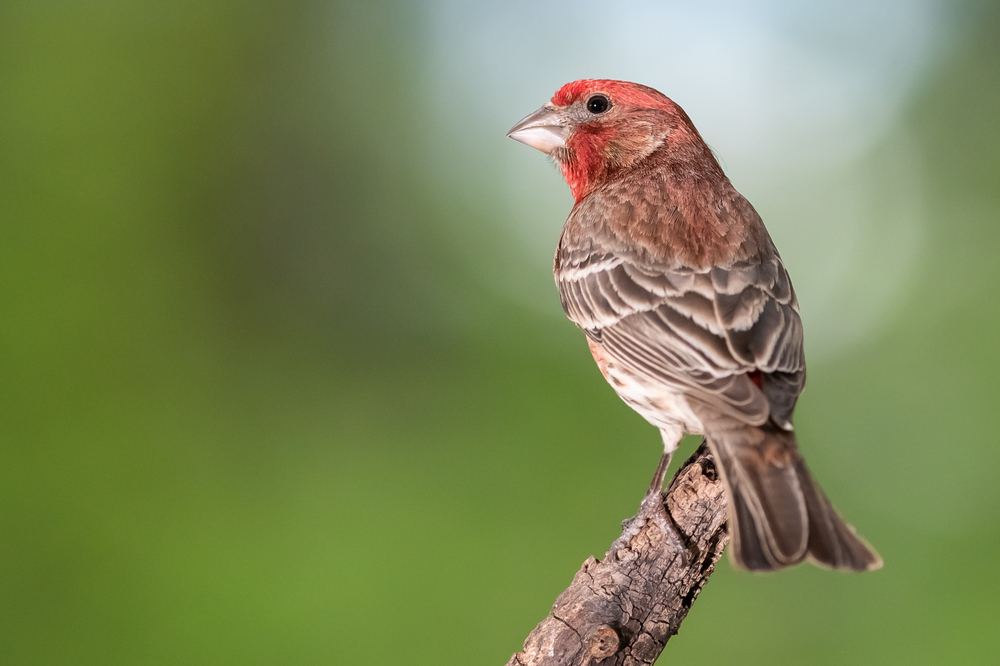
- Scientific Name: Haemorhous mexicanus
- Length: 5 – 6 inches
- Weight: 0.6 – 0.9 ounce
- Wingspan: 8 – 10 inches
The House finch is one of the most common birds to find in Utah. It can be seen nesting in shrubs or a building at heights between 5 and 35 feet. The male bird has a bright red body, unlike the female birds, which are pale grayish-brown.
This bird can be easily found in city parks, backyards, farms, and urban centers. It’s hard to miss a group of House finches because the birds are relatively noisy. This bird feeds on fruits, buds, and seeds.
Discover the enchanting world of Utah’s finches right here!
Red-Headed Woodpecker

- Scientific Name: Melanerpes erythrocephalus
- Length: 7.5 – 9.8 inches
- Weight: 2 – 3.4 ounces
- Wingspan: 16.7 inches
The Red-Headed Woodpecker is known for its bright red head and ability to catch flying insects. It’s found in the open woodlands of Utah and might visit your backyard feeder if you fill it with suet in winter.
This bird defends its territory fiercely and will puncture the eggs of other birds. It stores seeds and grasshoppers while they’re still alive but wedges them into crevices so they’re unable to move.
Roseate Spoonbill
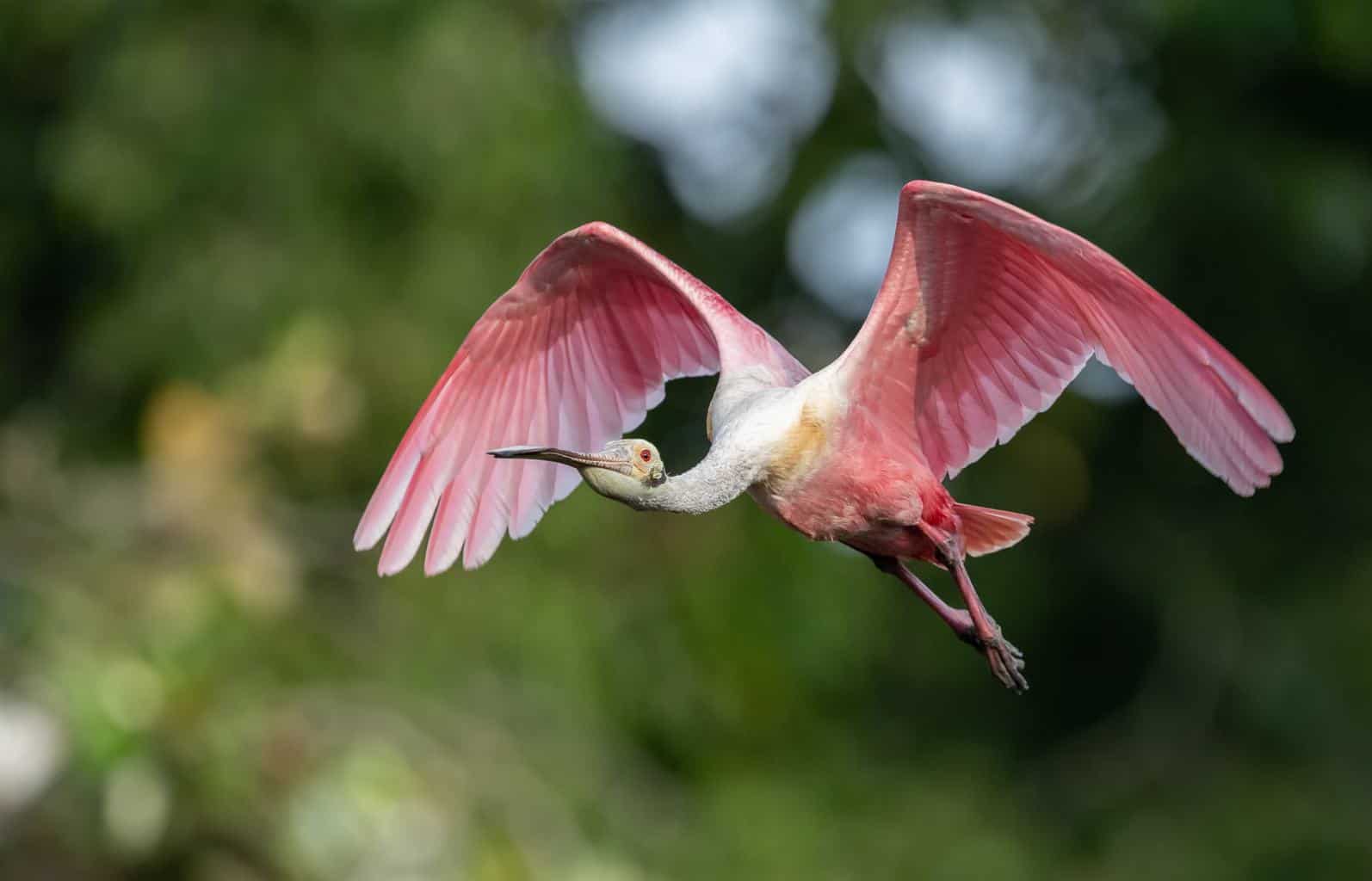
- Scientific Name: Platalea ajaja
- Length: 28 – 34 inches
- Weight: 2.6 – 4 pounds
- Wingspan: 47 – 52 inches
The Roseate spoonbill is found around the lakes in Utah, living in colonies and foraging in the water by moving its bill back and forth to catch invertebrates.
This bird has a football-shaped pale pink body, long legs, reddish-pink shoulders, and a yellowish-green head with a long bill that flattens into a spoon shape towards the end.
This is the only species of spoonbill that can be found in the Americas. It forages in shallow waters and usually feeds on aquatic insects, shrimps, and small fish. Older birds experience balding.
Red-Naped Sapsucker
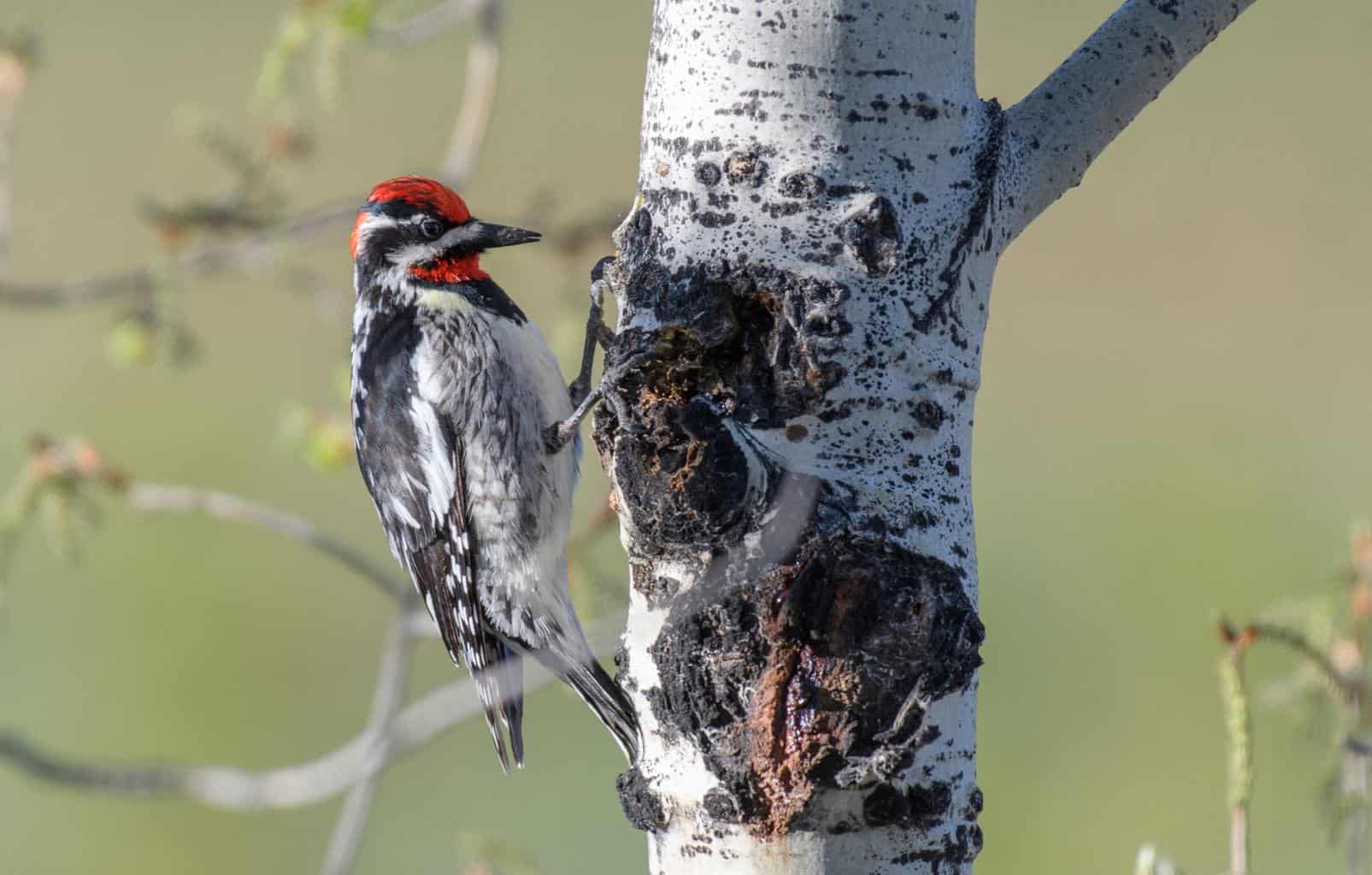
- Scientific Name: Sphyrapicus nuchalis
- Length: 7.5 – 8.3 inches
- Weight: 1.1 – 2.3 ounces
- Wingspan: 16.1 – 16.9 inches
The Red-naped sapsucker is easy to find in the areas around the Rocky Mountains where the willow trees grow. This bird digs small holes in the tree trunks to lick the sap and might even live in your backyard if you have aspen, birch, or pine trees.
This bird has a black and white body, while the throat, nape, and cap are bright red. The Red-naped sapsucker doesn’t suck the sap, but it sticks to the stiff hairs on its tongue, allowing the bird to lap it up.
It also feeds on insects that get caught up in the sap or are caught while they’re flying in the air.
Reddish Egret
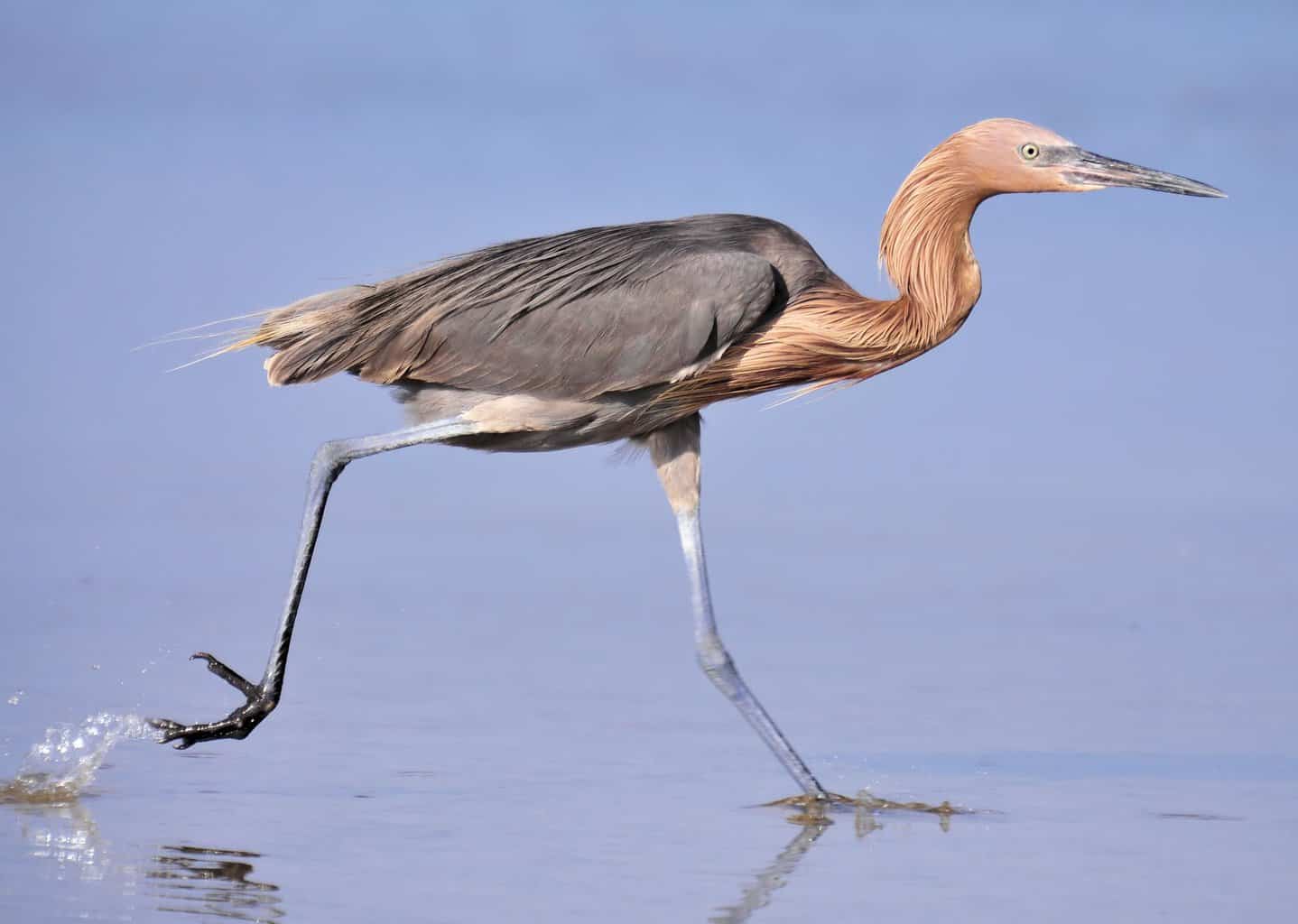
- Scientific Name: Egretta rufescens
- Length: 27 – 32 inches
- Weight: 0.8 – 1.92 pounds
- Wingspan: 46 – 49 inches
The Reddish egret is a large, elegant heron with white and dark morphs. The dark adult birds have pinkish cinnamon heads and necks with slate gray bodies and two-toned bills.
This bird forages for fish in saltwater bodies and uses its wings to create a shadow that startles the fish and then drives them toward land.
This behavior encourages the fish to stay in the shade and allows the Reddish egret to catch its prey without the confusing sun glare. It also feeds on shrimps and crabs.
Bluebirds in Utah
Mountain Bluebird
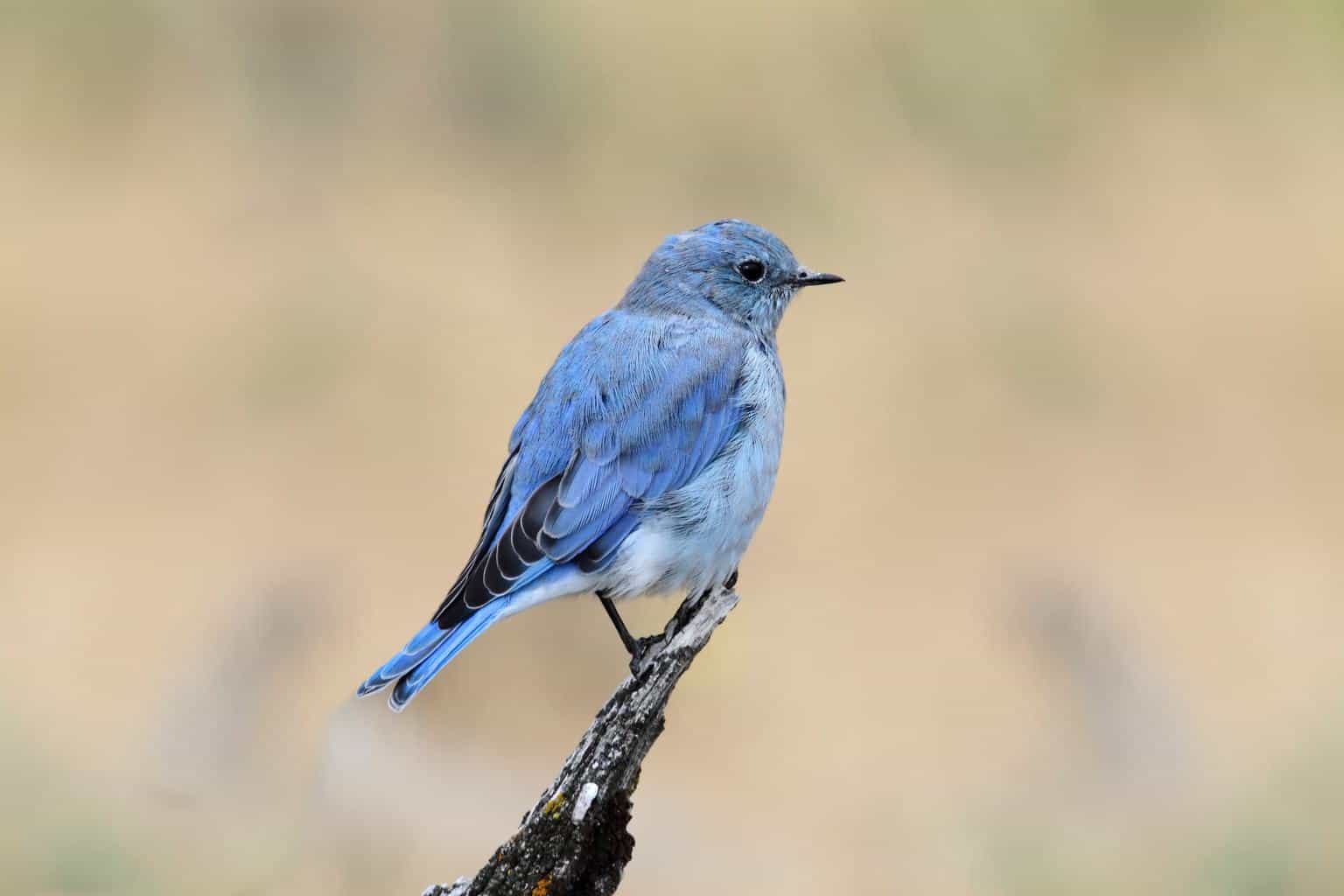
- Scientific Name: Sialia currucoides
- Length: 6.1 – 7.1 inches
- Weight: 0.85 – 1.31 ounces
- Wingspan: 11 – 14.2 inches
The Mountain bluebird can be seen in the open woodlands and parks of Utah. This bird is well known for its bright blue feathers, which are slightly darker on the wings. The female birds have blue wings, but the rest of the body is brownish-gray.
This bird isn’t shy of humans and can be easily found when it’s perching on fence posts or tree branches. It accepts nesting boxes, so you might be able to attract a breeding pair to your backyard.
During the breeding season, the Mountain Bluebird feeds on beetles and caterpillars. In winter, it feeds on grapes, berries, and seeds.
Western Bluebird

- Scientific Name: Sialia mexicana
- Length: 5.9 – 7.1 inches
- Weight: 0.8 – 1.1 ounces
- Wingspan: 11.4 – 13.4 inches
The Western bluebird spends most of the summer in Utah and then migrates throughout the state. It can be found in open fields, woodlands, and city parks.
The male bird has shiny blue upperparts with an orange chest and a bright blue throat. The female bird looks paler with gray-buff plumage.
The Western bluebird can be easily attracted to your backyard if you fill a bird feeder with mealworms. It mainly feeds on insects like grasshoppers, ants, caterpillars, and beetles but can supplement its diet with fruits and seeds.
Steller’s Jay
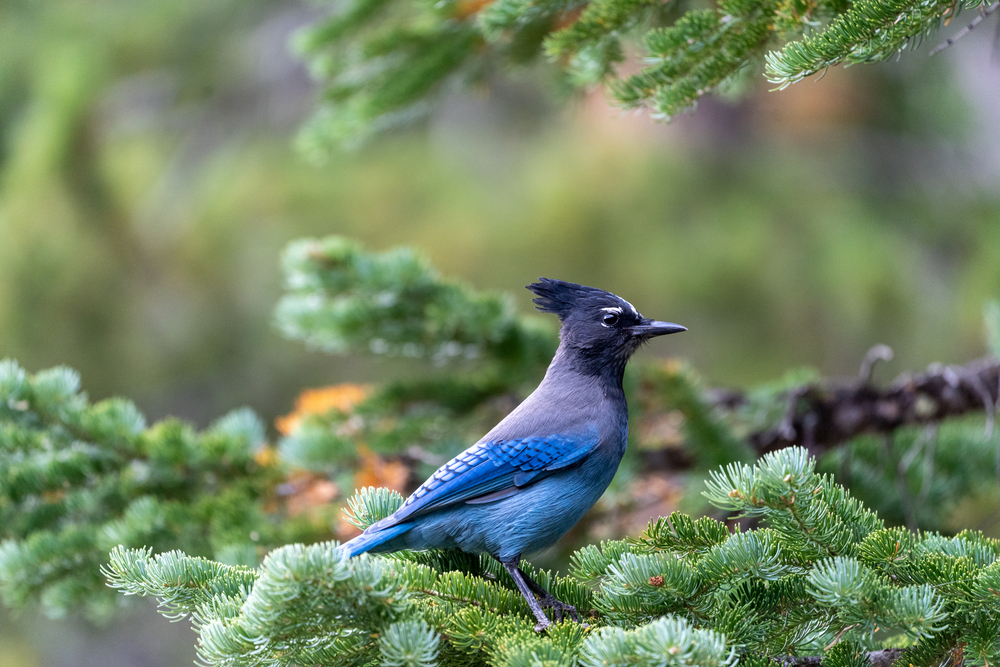
- Scientific Name: Cyanocitta stelleri
- Length: 12 – 13 inches
- Weight: 3.5 – 4.9 ounces
- Wingspan: 17.3 inches
Steller’s jay has a black head with bright blue plumage that covers the entire body. It’s an abundant bird in Utah, usually found in coniferous forests and open woodlands, where it builds its nest above the ground.
This bird is a forager that feeds insects, seeds, nuts, berries, the eggs of other birds, small mammals, and sometimes nestlings. Because it doesn’t mind being around people, Steller’s jay feeds on picnic leftovers and garbage.
If you want to attract Steller’s jays to your backyard, you have to fill your bird feeder with large seeds, suet, and peanuts. This bird accepts food from people and can steal food from other birds.
Black-Throated Blue Warbler
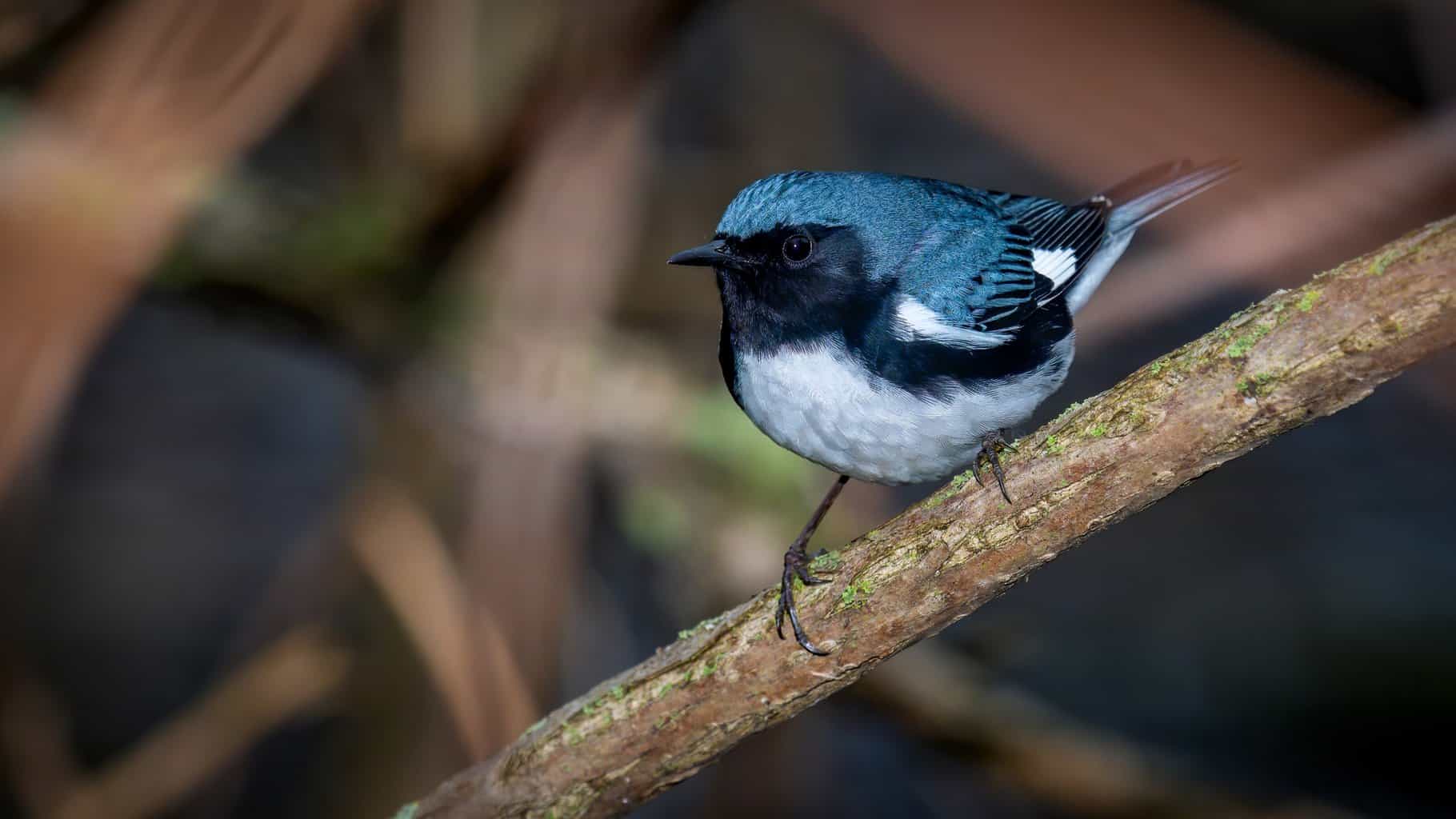
- Scientific Name: Setophaga caerulescens
- Length: About 5.1 inches
- Weight: 0.30 – 0.44 ounce
- Wingspan: 7.5 – 7.9 inches
The Black-throated Blue warbler is a shy bird that prefers to live in the undisturbed forests of Utah, where the dense cover provides shelter.
Male birds have midnight blue upperparts and underparts, while female birds are grayish olive. Both sexes have a small white squared spot on the wings.
It will be easier to locate this bird during the breeding season by looking through the lower canopy rather than through treetops. It searches the leaves for insects and usually catches the insects found on the underside of leaves.
Blue Jay

- Scientific Name: Cyanocitta cristata
- Length: 9 – 12 inches
- Weight: 2.5 – 3.5 ounces
- Wingspan: 13 – 17 inches
The Blue jay is found east of the Rocky Mountains, especially in winter. This is a large songbird with blue and black plumage and white underparts. It’s known for its intelligence, and you can easily detect its presence through its noisy calls.
The Blue jay carries a seed with its feet and then pecks it open. It also carries food and stores it in its throat poach. It feeds on nuts, seeds, grains, and even injured and dead invertebrates. In some cases, the Blue jay raids nests for eggs and nestlings.
Blue Grosbeak

- Scientific Name: Passerina caerulea
- Length: 5.5 – 7.5 inches
- Weight: 0.92 – 1.11 ounces
- Wingspan: 10 – 11 inches
This migratory bird is a frequent cowbird host and can be found in several areas in Utah. Adult birds are rich blue with a black facial mask and chestnut wing bars. Female birds are cinnamon-brown, with paler feathers on the underpants.
The Blue grosbeak isn’t easy to find during summer. However, you can pay attention to the male’s song, as the birds prefer to sing from high, exposed perches. This bird feeds on grasshoppers and crickets but will be attracted to a bird feeder if you fill it with grains.
Woodhouse’s Scrub-Jay
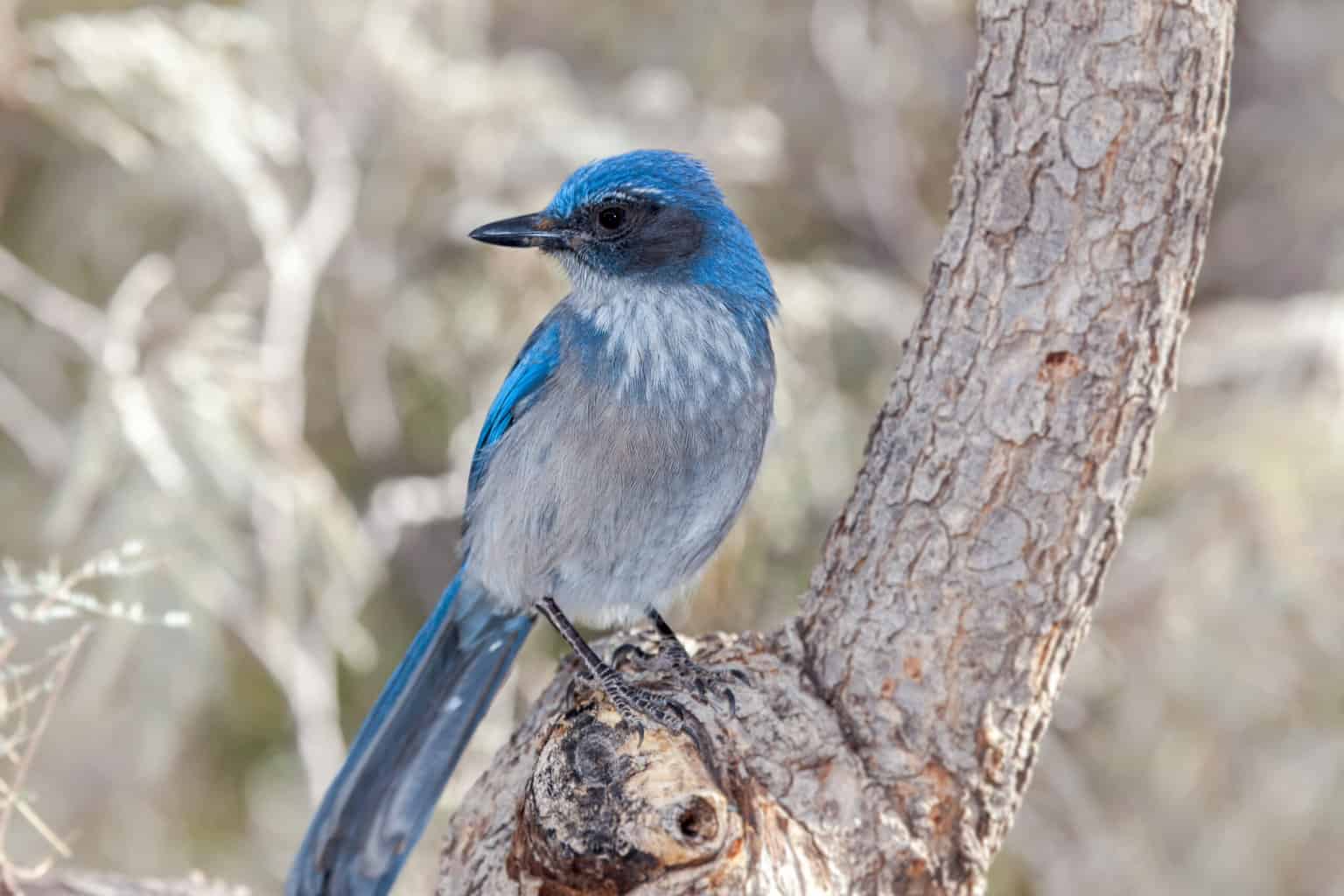
- Scientific Name: Aphelocoma woodhouseii
- Length: 11 – 12 inches
- Weight: About 2 ounces
- Wingspan: About 15 inches
Woodhouse’s Scrub-jay is a large songbird with light blue above, a whitish throat, and a grayish belly. It can be found among the pinyon pine trees, backyards, and pastures. You can find this bird at lower elevations throughout the parks of Utah.
This bird feeds on insects and fruit during summer, but switches to seeds and nuts in winter. It sometimes feeds on lizards and nestlings, usually finding the nest by following the parent birds.
Fill your backyard feeder with sunflower seeds and peanut butter to attract Woodhouse’s Scrub-jay.
Green Birds in Utah
Green Heron

- Scientific Name: Butorides virescens
- Length: 16 – 18 inches
- Weight: About 8.5 ounces
- Wingspan: 25.2 – 26.8 inches
The Green heron looks dark from a distance, but the plumage appears deep green on the back with a rich chestnut chest and neck in good light.
This bird can be found near wooded ponds and streams. It stands still and uses its dagger-like bill to catch fish and amphibians from the water. It prefers to stay concealed among heavy vegetation, unlike the bigger herons.
The Green heron is one of the few birds that use tools like insects, twigs, and bread crusts to lure fish. It rarely dives into the deep water to catch fish.
Broad-Billed Hummingbird

- Scientific Name: Cynanthus latirostris
- Length: 3.1 – 3.9 inches
- Weight: About 0.1 ounce
- Wingspan: About 5 inches
The Broad-billed hummingbird has glittering plumage, a bright green body, a blue throat, and a red bill. Female birds have golden-green bodies and gray underpants. It can be found in high-elevation meadows, pine forests, and near shrubby habitats.
This hummingbird is attracted to the sounds of diurnal owls and usually dives at the owl’s head in a behavior known as mobbing.
These actions usually warn other birds of the predator’s presence. It’s a frequent visitor to residential gardens and hummingbird feeders.
Orange Birds in Utah
Allen’s Hummingbird
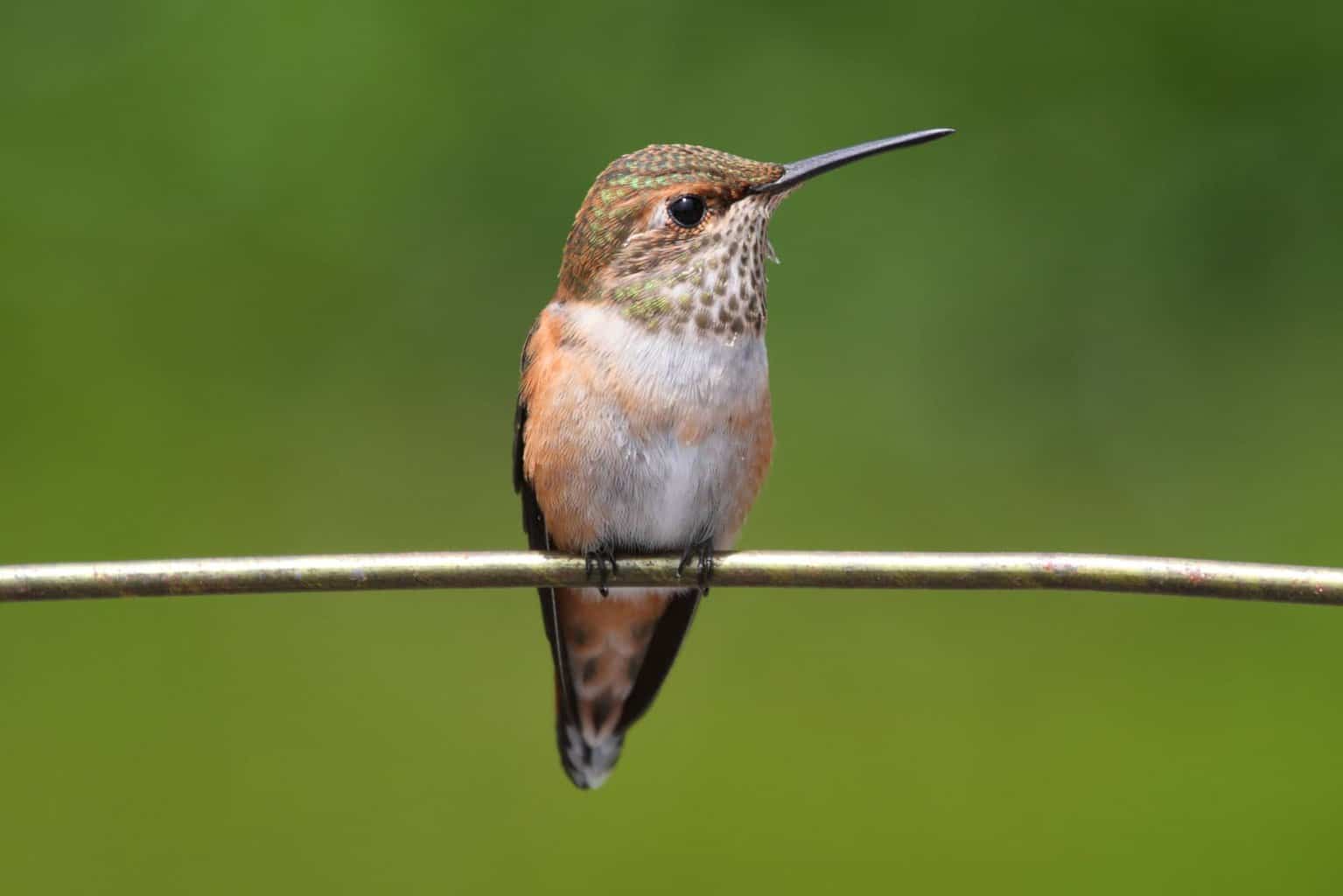
- Scientific Name: Selasphorus sasin
- Length: 3 – 3.5 inches
- Weight: About 0.1 ounce
- Wingspan: About 4.3 inches
Allen’s hummingbird is common in the woodlands and gardens of Utah. It has coppery-orange plumage with a deep orange gorget. Male birds usually flash their shiny gorgets and put on a show for females, which have paler plumage.
This hummingbird is easily found during spring. You can attract Allen’s hummingbird by setting up a bird feeder in your backyard and filling it with sugary water or by planting flowers.
Allen’s hummingbird flies back and forth in a pendulum-like movement. It uses its feet to control its body temperature, tucking them in to keep its body warm or dangling them to cool off.
Orange-Crowned Warbler
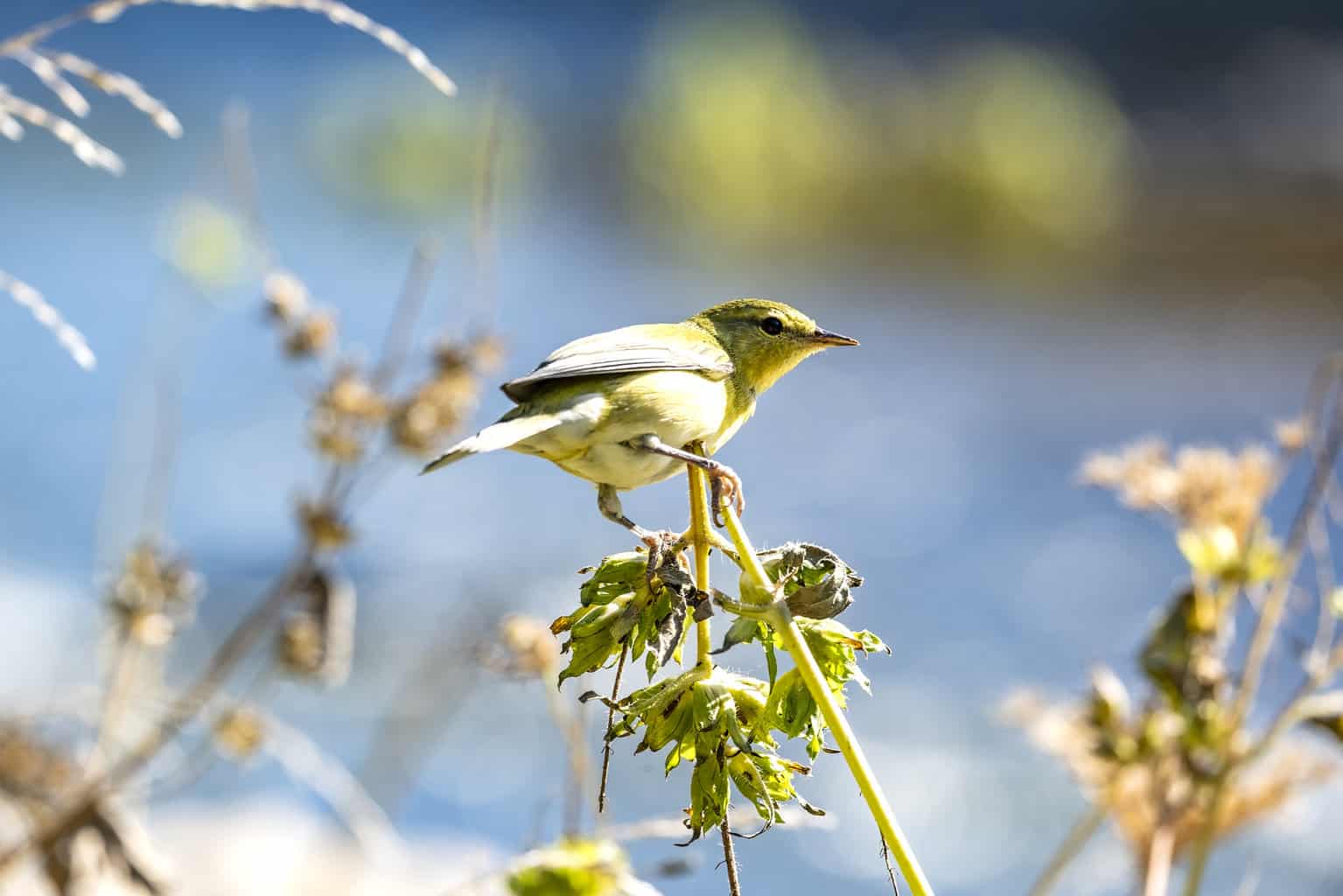
- Scientific Name: Leiothlypis celata
- Length: 4.8 – 5.3 inches
- Weight: About 0.32 ounce
- Wingspan: About 7.25 inches
This bird is greenish-yellow or olive but has a distinctive orange crown that is only visible when the bird raises its head feathers in excitement. It forages quietly and usually prefers to nest on the ground to avoid nest-robbing birds.
The Orange-crowned warbler visits backyards for suet, peanut butter, and sugary water. It usually feeds on invertebrates, ants, spiders, flies, and caterpillars.
It supplements its diet with fruits, seeds, and berries and visits the sap wells that woodpeckers excavate.
Yellow Birds in Utah
American Goldfinch
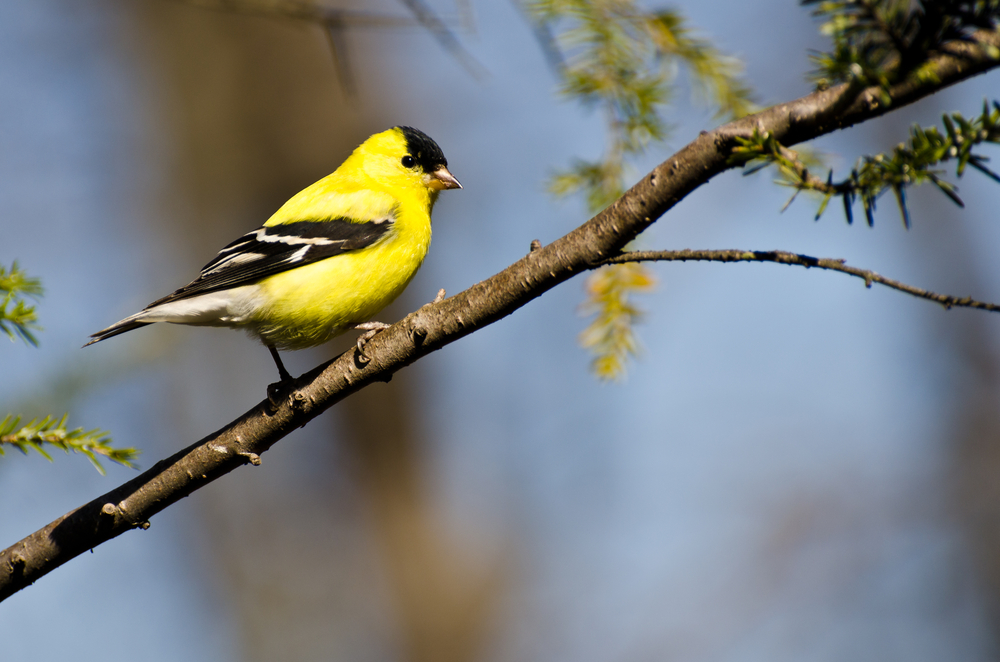
- Scientific Name: Spinus tristis
- Length: 4.3 – 5.5 inches
- Weight: 0.39 – 0.71 ounce
- Wingspan: 7.5 – 8.7 inches
The American goldfinch is found across Utah most of the year and can be easily spotted due to its distinctive acrobatic flying style. Male birds have bright yellow bodies with black foreheads, while females are pale olive with yellow bellies.
Unlike other finches, this bird molts its feathers twice a year, and its bright plumage signifies spring has started. It feeds on seeds and will be attracted to your backyard feeder if you fill it with nyjer and sunflower seeds.
Dickcissel
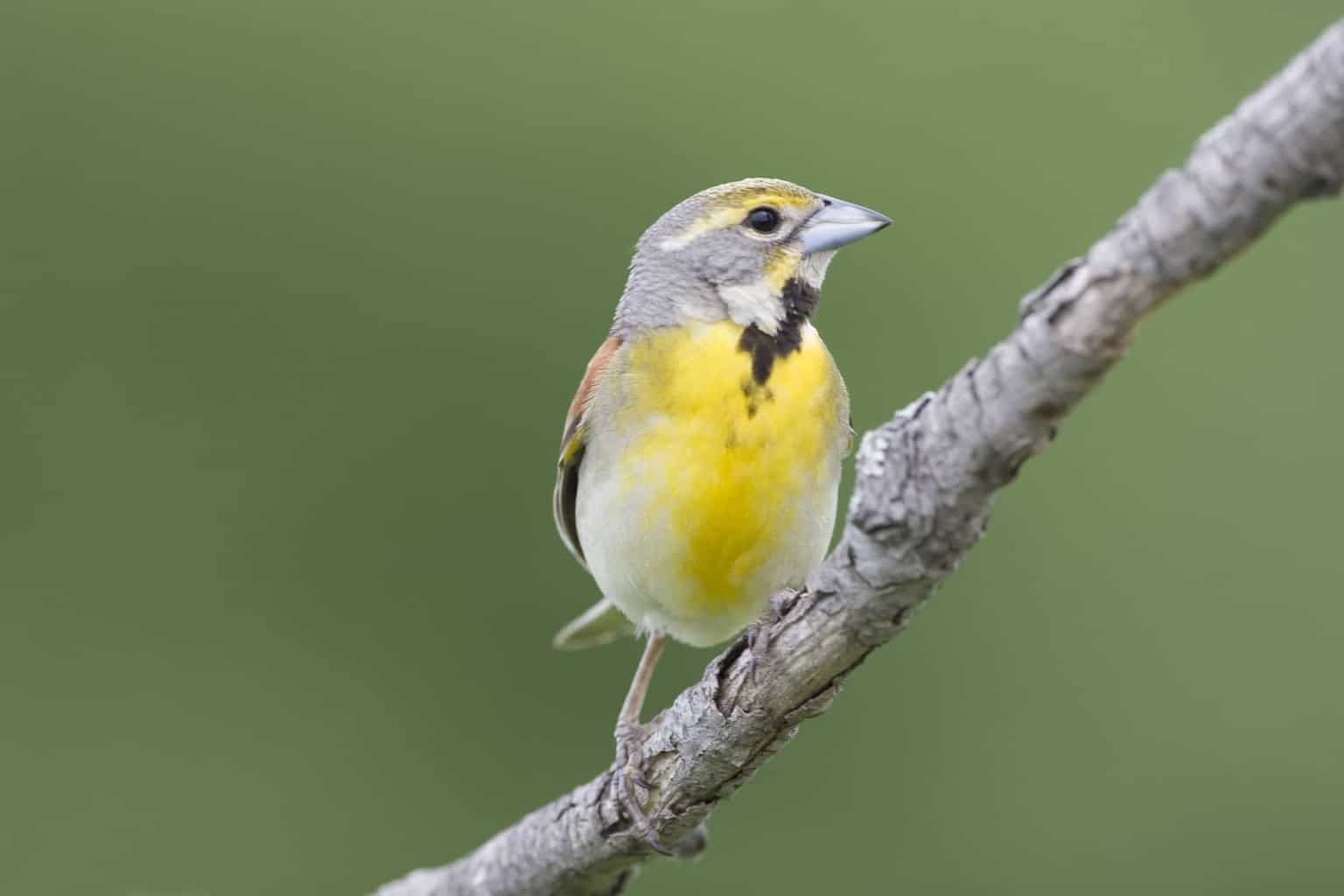
- Scientific Name:Spiza americana
- Length: 5.5 – 6.3 inches
- Weight: 0.9 – 1.4 ounces
- Wingspan: 9.8 – 10.2 inches
The Dickcissel is a small bird that can be found across the Rocky Mountain region. It has a grayish body and a yellow face and chest. Female birds look paler and lack the black throat patch that makes males easier to notice.
During migration, these birds gather in large flocks that might contain thousands of birds. The Dickcissel perches on stalks or shrubs and feeds on insects and seeds. The bird can hull and eat up to a dozen sorghum seeds per minute.
Northern Parula
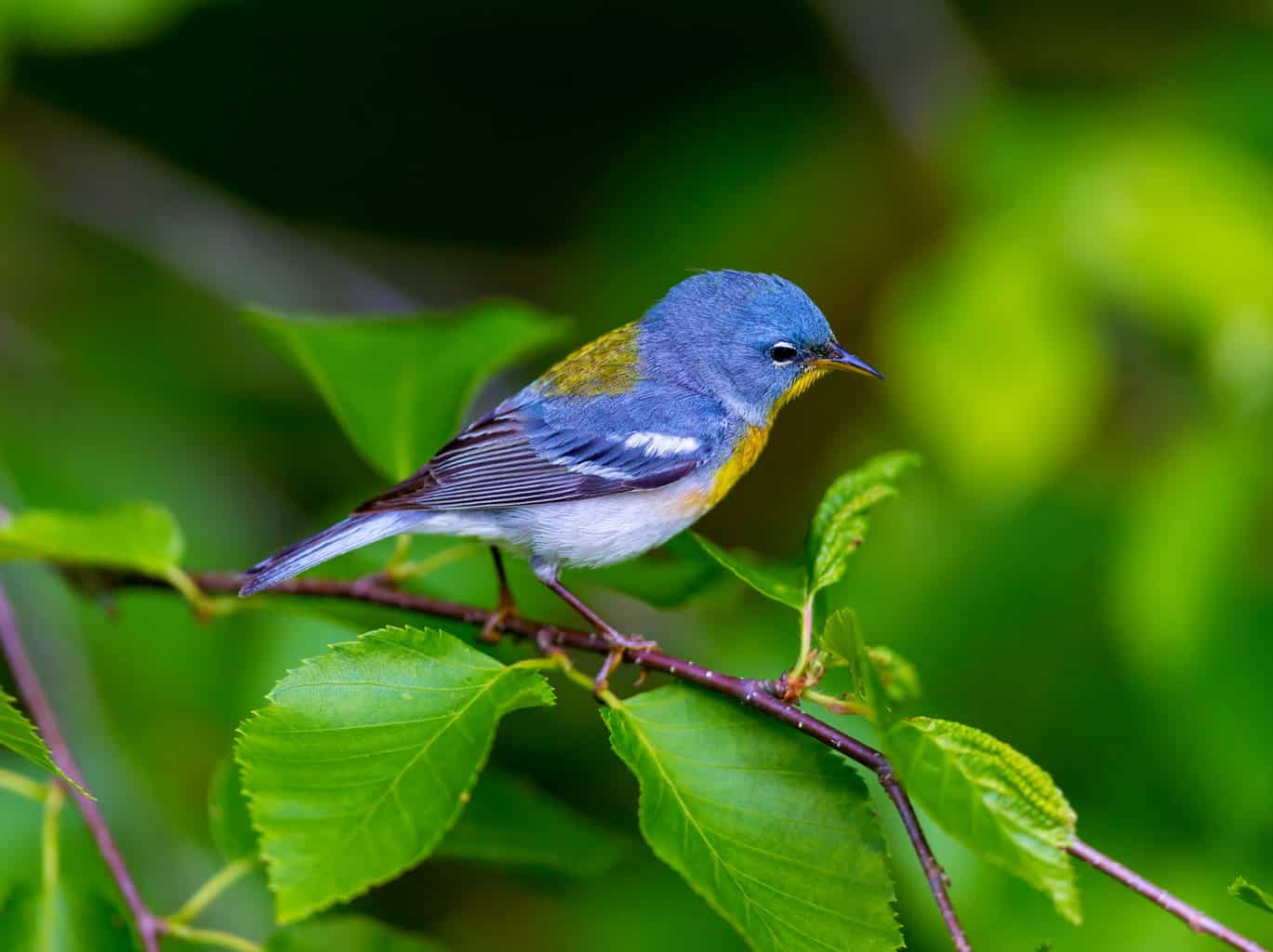
- Scientific Name: Setophaga americana
- Length: 4.3 – 4.9 inches
- Weight: 0.18 – 0.39 ounce
- Wingspan: 6.3 – 7.1 inches
The Northern parula is a bluish-gray bird with a yellow patch on the back and white wing bars. Female birds are paler and lack the male’s chestnut chest band. It prefers to nest in mossy trees.
The birds found in the western part of this bird’s range sing differently than the ones found in the eastern part.
The Northern parula feeds on beetles, caterpillars, moths, ants, bees, and wasps, but it doesn’t visit backyard feeders. It sometimes feeds on berries and seeds during the winter.
Other Birds to Watch For In Utah
Dusky Grouse
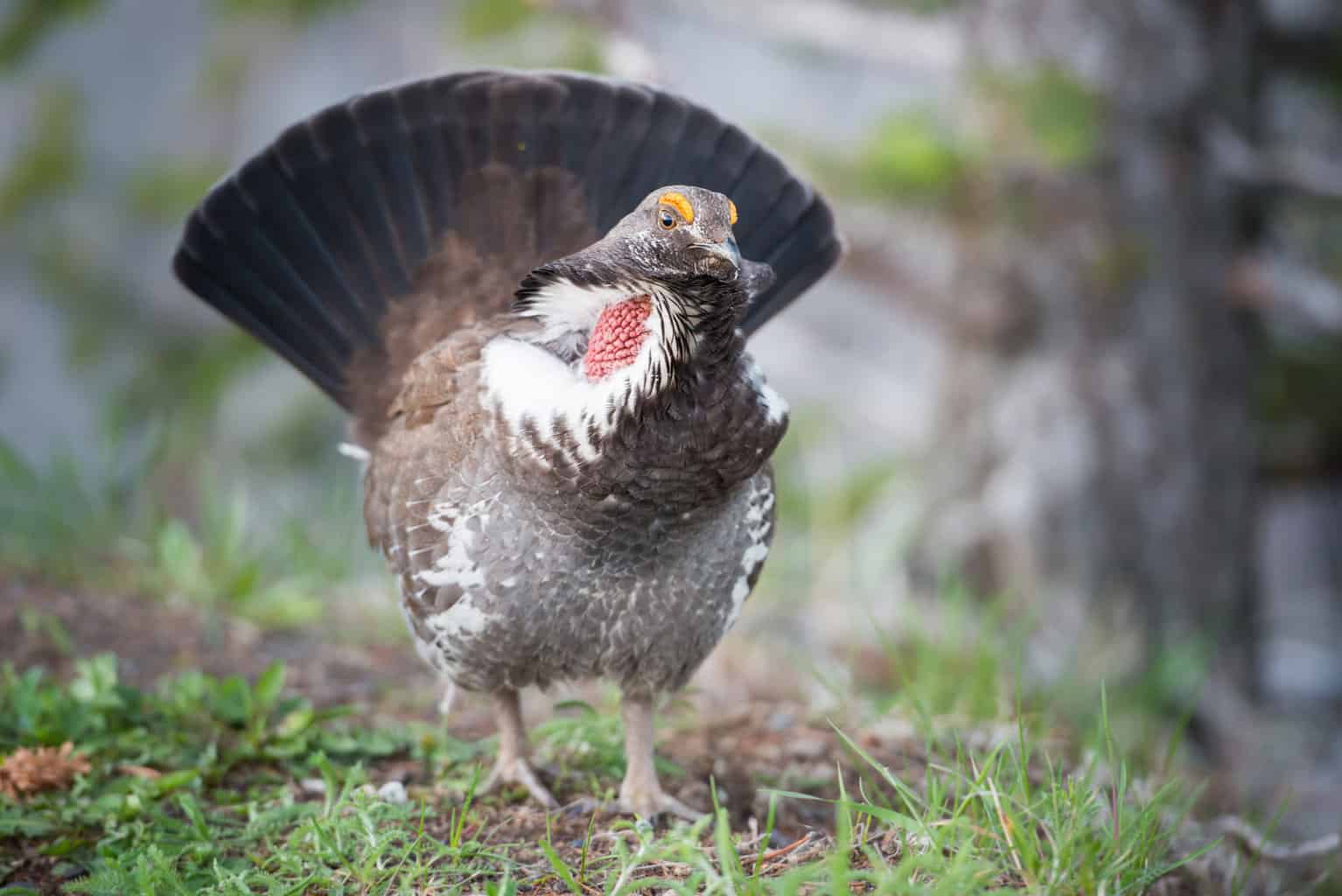
- Scientific Name: Dendragapus obscurus
- Length: 17.3 – 22.4 inches
- Weight: 40.9 – 45.2 ounces
- Wingspan: 25.6 – 26.4 inches
The Dusky grouse is native to the Rocky Mountains and is a popular game bird in Utah. The birds have mottled plumage with brown, white, gray, and black feathers. Male birds have purplish-red air sacs on the neck.
This bird spends most of its time resting and forages the ground for seeds and insects, especially in the summer. You’ll have a better chance of finding this bird if you go hiking through a mountain forest.
Great Horned Owl
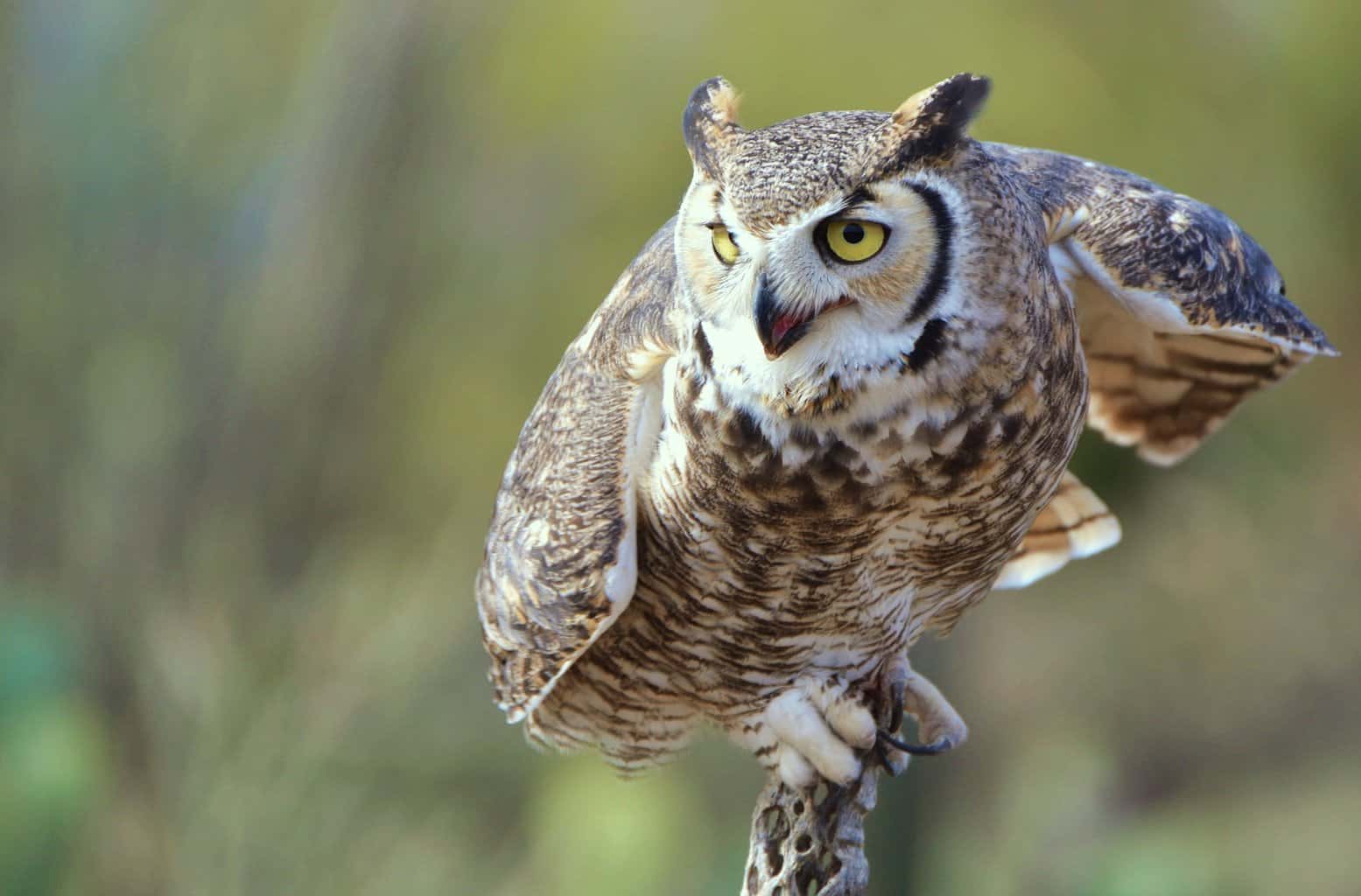
- Scientific Name: Bubo virginianus
- Length: 17 – 25 inches
- Weight: 32 – 88 ounces
- Wingspan: 3 – 5 feet.
The Great horned owl is common in several habitats in Utah, including woodlands, mountains, deserts, urban areas, and coastal swamps. You can attract a breeding pair to your backyard by setting up a nesting box.
This bird has a mottled grayish-brown body with a reddish face and ear tufts that look like horns. It has a diverse diet that ranges from scorpions and tiny mammals to skunks, geese, and other raptors. It even supplements its diet with reptiles and fish.
House Sparrow

- Scientific Name: Passer domesticus
- Length: About 6.3 inches
- Weight: 0.85 – 1.39 ounces
- Wingspan: 7.5 – 9.8 inches
House sparrows have gray heads, white cheeks, and rufous necks, but female birds are more buffy-brown. This bird can be found in several areas in Utah, including backyards, parks, and city streets. It can often be seen hopping on the ground.
House sparrows visit backyard feeders, usually feeding on sunflower seeds, millet, and corn. The birds also feed on seeds, livestock feed, and discarded food. In summer, House sparrows feed on insects and feed them to their young.
Violet-Green Swallow
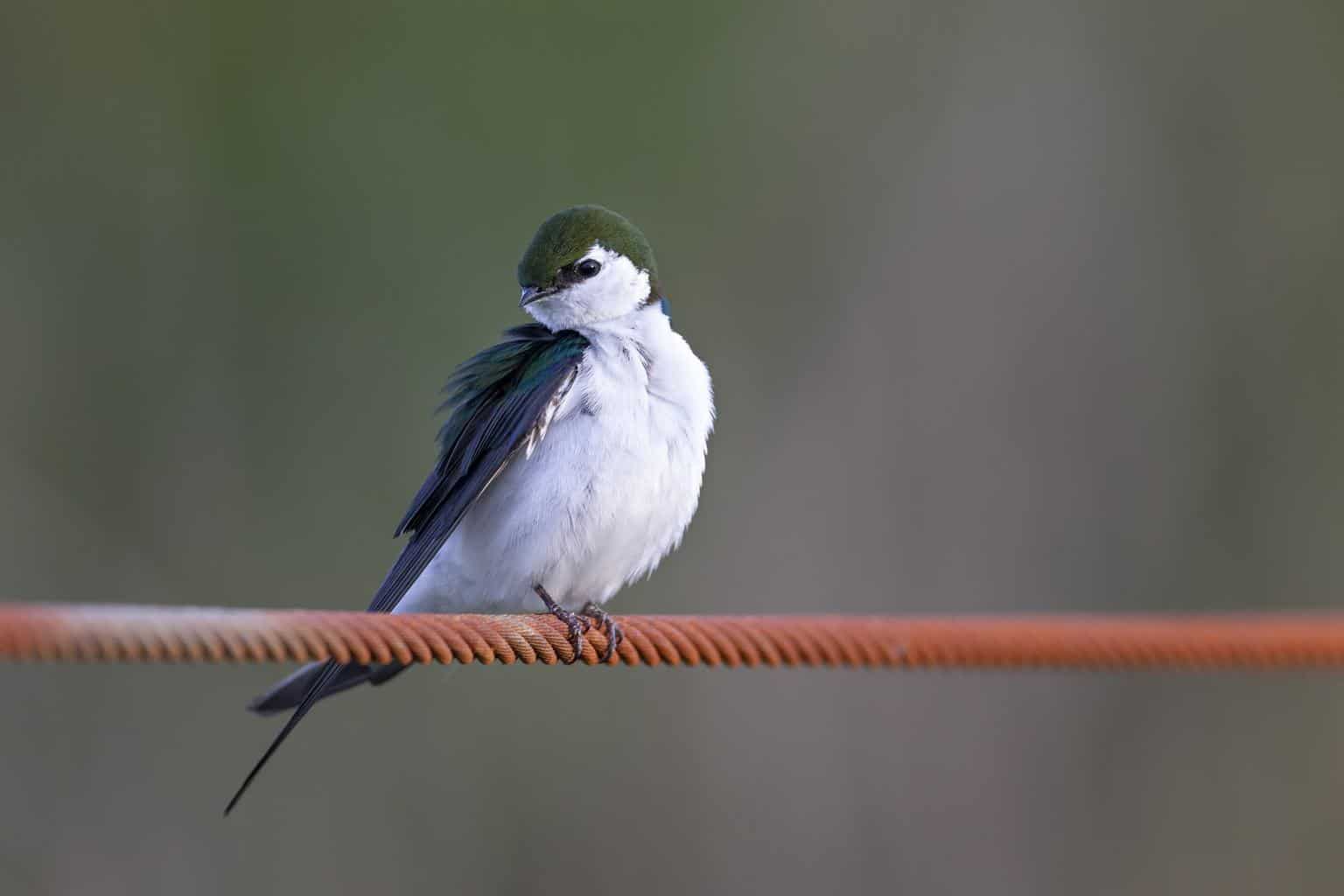
- Scientific Name: Tachycineta thalassina
- Length: About 5 inches
- Weight: About 0.5 ounce
- Wingspan: About 10.6 inches
The Violet-green swallow is found in several habitats in Utah during the summer, usually residing in mid-elevation aspen forests.
It has a bright green body with a distinctive violet rump. Male birds have white cheeks, while female birds are slightly paler and have dusky cheeks.
This bird usually prefers to hang out with other swallows, catching flies, leafhoppers, leaf bugs, and winged ants early in the morning. You’ll be able to attract a breeding pair if you have dead trees on your property or set up a nesting box.
Snowy Plover
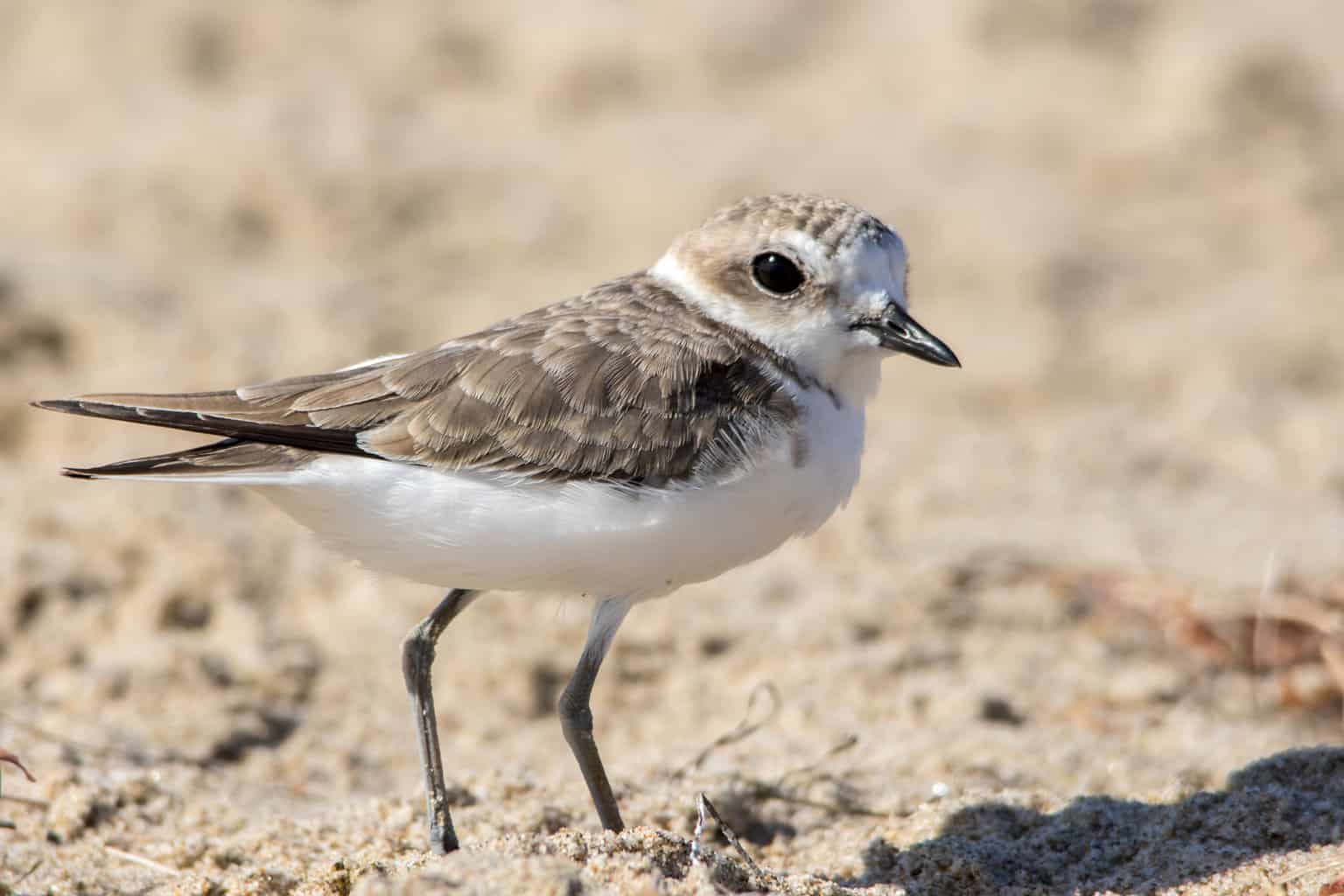
- Scientific Name: Charadrius nivosus
- Length: 5.9 – 7 inches
- Weight: 1 – 2 ounces
- Wingspan: 13.4 – 17 inches
The Snowy plover is pale sandy brown with white underneath, a black spot behind the eye, and another on the crown. It often forages on sandy and open landscapes and is usually found around the Great Salt Lake all year.
This bird leaves the nest three hours after hatching and can go foraging without assistance, although the parent notifies the young birds in case of danger. The Snowy plover feeds on invertebrates, including insects and crustaceans.
Red-Tailed Hawk

- Scientific Name: Buteo jamaicensis
- Length: 17.7 – 25.6 inches
- Weight: 24.3 – 51.5 ounces
- Wingspan: 44.9 – 52.4 inches
The Red-tailed hawk is the most common bird of prey that can be seen across Utah. However, it’s not likely to be seen in backyards or chasing pets.
This bird has brown plumage that gets paler towards the bottom. The tail has cinnamon feathers that give the hawk its name.
You can see this hawk if you go for a drive while looking out for fenceposts. It feeds on mammals like voles, mice, ground squirrels, and jackrabbits. It also feeds on other birds.
Wrap Up
Wherever you go in Utah, you’ll be able to see some of its amazing birds chasing their prey or perching. Some of the birds are only widespread in summer, while others are abundant all year.
Study the behavior of your target species, and you’ll be able to decide on the best time and place to watch the birds. Some birds aren’t shy and will come and visit your backyard often.

